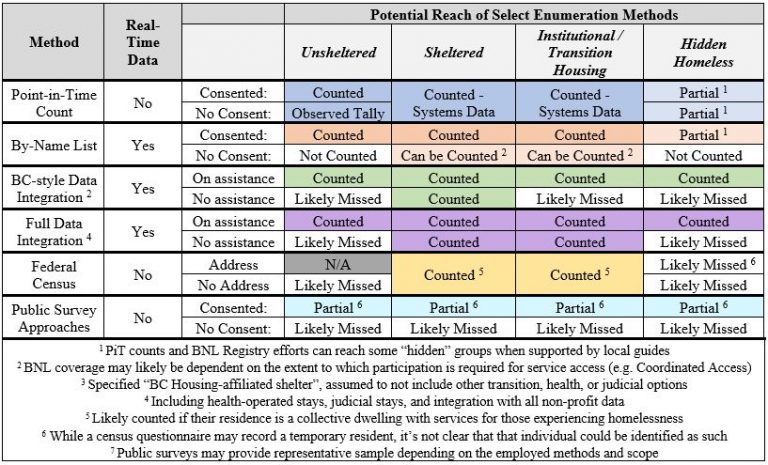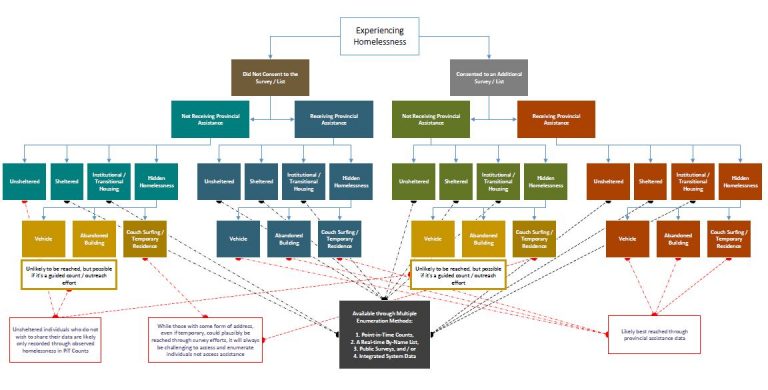As with other sectors, the provision of services to those experiencing or at risk of homelessness faces dual, interrelated pressures. Firstly, stakeholders must maximize impact, using limited resources to advance the most promising evidence-based practices in hopes of providing the best available support for those in need. Secondly, those in charge of funding or implementing programs and practices must then collect and monitor data for efficacy, and adapt to real-time trends. Enumeration of those experiencing homelessness at an organizational, community, provincial, and / or federal level represents a core tool, particularly as one core, overarching goal for each level is a reduction in such experiences (in addition to other individual-level outcomes related to experience and wellbeing).
The ways in which we have quantified experiences of homelessness have shifted and grown over time, in accordance with both our conceptualizations of the issue as well as shifting technological costs and capacities. There now exists a range of demand-side methods for estimating the prevalence of homelessness, many of which have been recently implemented at different levels and at different times.
| Method | Definition | Source / Link |
| Point-in-Time Count | Point-in-Time (PiT) Counts are a community-level measure of sheltered and unsheltered homelessness; they typically take place every couple of years on a single night between March 1 and April 30. | Government of Canada – Reaching Home |
|
By-Name List
|
A By-Name List is a real-time list of all known people experiencing homelessness in your community. | Built For Zero Canada |
| BC-style Data Integration | In Phase 1 of an ongoing data innovation project, the Government of BC sought to estimate the number of people experiencing homelessness throughout 2019. The analytic definition of the 2019 Homelessness Cohort integrates SDPR BC Employment and Assistance program no fixed address (NFA) data and BC Housing Homeless Individuals and Families Information System (HIFIS) shelter use data with the Ministry of Health Medical Services Plan (MSP) client registry as the population directory used to link the data. | Preventing and reducing homelessness: an integrated data project
(Government of BC) |
| Full Data Integration | The above could in theory be expanded to include relevant NFA stays in health facilities, judicial facilities, and non-profit facilities at a provincial level, and could also be integrated with NFA data through federal support programs (e.g. CPP, EI, etc.) | |
| Federal Census | The Canadian census is a nationally distributed questionnaire to enumerate and provide information on the entirety of the resident population. It includes those residing in private dwellings and in collective dwellings (and may include those with a temporary address if interpreted as a resident by whoever filled the questionnaire). | See Statistics Canada regarding methodology, and examples of omissions |
| Public Survey Approaches | Other survey methodologies can be used to inform prevalence and provide context, with both broad or narrow scopes as well as representative or non-representative samples. | For example, recent youth-oriented surveys through Upstream Kelowna or Penticton’s Youth Homelessness Research Project |
Each method carries its own distinct set of assumptions, costs, benefits, and limitations, as well as its own feasibility considerations dependant on scope, access, and other factors. Many of the challenges and opportunities related to enumeration data were summarized in a prior KHRC post within the context of estimating trends in migration. The overall reach differs across methods, as well as in terms of the conditions of those they seek to enumerate. For example, PiT counts reports typically draw from systems data for congregate sector and institutional housing, survey data with those residing in shelters or unsheltered locations, as well as tally sheets recording individuals perceived to be homeless but who were not surveyed. For a By Name List to have the same reach, it would need to be equally embedded into existing homelessness management information systems, and have some method of tracking the number of individuals abstaining from sharing their name and information. Some individuals would be captured by any method, whereas others are much easier to miss. The below table seeks to explore some of these potential differences (though reach can likely vary depending on the implementation of a given method).
From the rough sketch above (and the corresponding figure overview below), we seem that each method likely has its own associated strengths and gaps in terms of reaching individuals with varied experiences of homelessness and associated services and supports. While a multi-method approach would logically lead to better coverage, the rapid decline in marginal gains with each added method limits combined with a limited supply of funding greatly restricts the possible scope of inquiry.
*Click to enlarge*
However, this context does carry a critical lesson relevant to all those seeking to estimate experiences of homelessness: we must be highly intentional in selecting and implementing the tools we use, as they inherently determine the types of experiences that are counted, as well as the experiences that are missed. And while it is perhaps inevitable that some individuals are missed despite our best efforts, we must work diligently and critically to ensure that there aren’t any systematic knock-on effects excluding specific types of experiences from subsequent plans, strategies, and goals developed on the basis of incomplete data.
At the end of the day, enumeration also requires the respectful and intentional collection, aggregation, and use of individual experiences, real people with their own unique stories, challenges, and strengths. That broader understanding should be carried throughout all enumeration work and strategy development, from how data are collected, to how it is aggregated (and disaggregated), to how those data are represented in any resulting outputs.
Enumeration remains a critical aspect in reviewing progress towards keeping homelessness rare, brief, and non-recurring. We hope to explore there and related topics in subsequent analyses and discussions, and welcome anyone with feedback on these topics to reach out to us at ask.khrc@ubc.ca
Enumeration and Data in Kelowna
Aspects of enumeration and data were documented in detail within Kelowna’s Journey Home Strategy Mid-Term Report, which was released April 27th, 2022.
Related goals for the community were summarized on page 6:
- By October 31st, 2022 90% of agencies submitting reliable data to COJHS for the By Name List
- By October 31st, 2022 100% of coordination tables using the By Name List
- By March 31st, 2023 90% of agencies participating in HMIS
- By December 31st, 2023 public facing dashboard developed and released
- By December 31st, 2023 introduce Coordinated Access for families
Additional context on the community’s approach in developing “data for decision making”, as well as information on progress to date, were provided across pages 13-14 of the report:
Data plays a pivotal role in achieving our future targets, both through ensuring a person-centered lens in service delivery, and in guiding how investments should be made to reduce and prevent homelessness across the system.
Historically, data that paints a picture of who is experiencing homelessness, and the inflow/outflow of homelessness has been scarce and fragmented in our community. Without comprehensive data that is representative of the homelessness population, we cannot adequately predict the need for housing and homelessness response services, nor can we measure our progress and impact on a systems level.
Over the past number of months, the City of Kelowna and COJHS have partnered with consultants to develop a data modelling tool to help inform projected supportive housing numbers required across our community. This project has evidenced the complex nature of harnessing quality data across the system; and developing a predictive model that considers unique local housing affordability trends.
To inform the development of the model, we utilized data on the number of people currently experiencing homelessness which is derived from data sources such as the PiT Count and the HIFIS database used by BC Housing. For the purpose of developing a model, different data sources are more or less reliable and valid at counting segments of the homeless population, but each come with their own weaknesses.
Fundamentally, the universe of people experiencing homelessness – meaning everyone who is experiencing homelessness – is never fully determined by any one currently available data source. Some people will seek out services and may be registered in a database and thereby become visible– but many others may remain among the hidden homeless. Of those who consent for their information to be recorded (i.e., in HIFIS or on a By-name List) only a subset would be imminently houseable – meaning they would meet any eligibility requirements and are available and have completed any essential paperwork.
As such, static data sources cannot identify the number of people ready to be housed in this moment. Until this gap can be closed by a By-Name list approach, embedded in a community-wide Coordinated Access process, our models have to consider known limitations of static available data sources to the best of our abilities. While our efforts could not glean a perfect picture of future needs, we were able to establish a range of supportive housing needs based on available information, utilizing some qualitative considerations. A copy of the report is included as an addendum to this Report.
As we reflect on the work ahead, we are confident that our ability to measure impact and develop a clear understanding of housing needs in future will be embedded across the community. COJHS has worked tirelessly over the past few years to develop solid mechanisms for data, navigating the complexity of information sharing challenges, and fragmentation of the system. We are thrilled to be working to embed a framework for system-wide data, to include a By-Name List and a Homelessness Management Information System (HMIS), to roll out in 2022/2023. Based on federal directives and national best practices, this framework will provide us with the information necessary to inform housing and shelter needs, and to predict future needs based on real-time data and trends. We will also be able to determine the need for supports along the spectrum from prevention and diversion to emergency responses, through to housing. On a client level, operators will be able to offer integrated inter-agency case management as well as reduce duplication, while ensuring that we bridge the gaps for those we serve.


